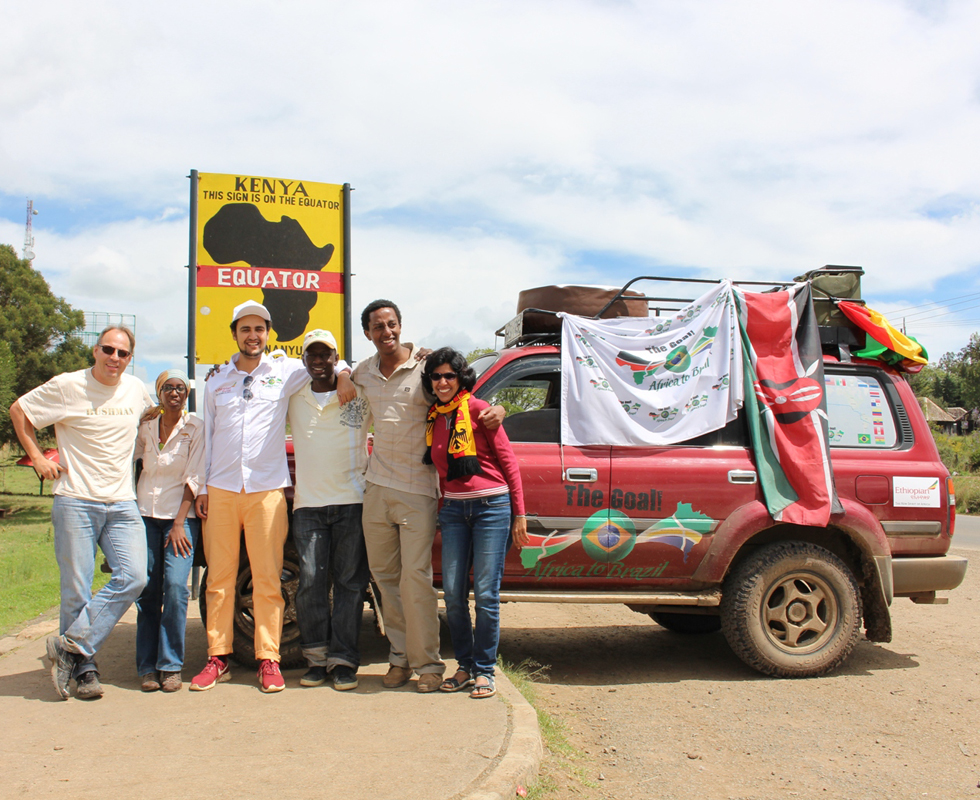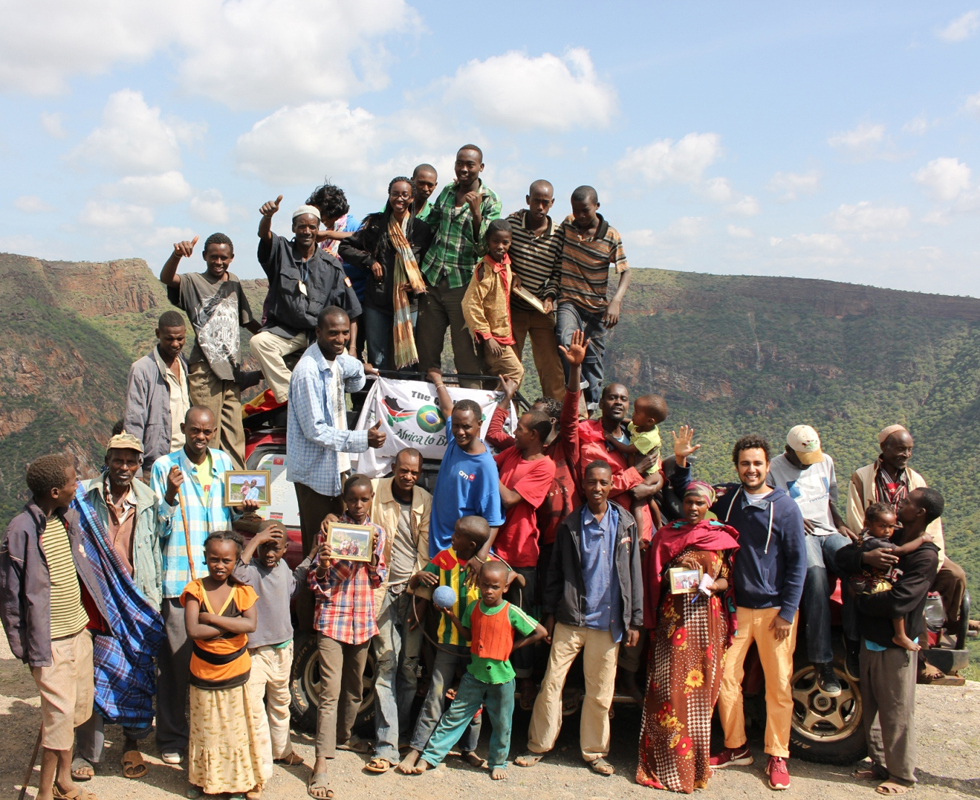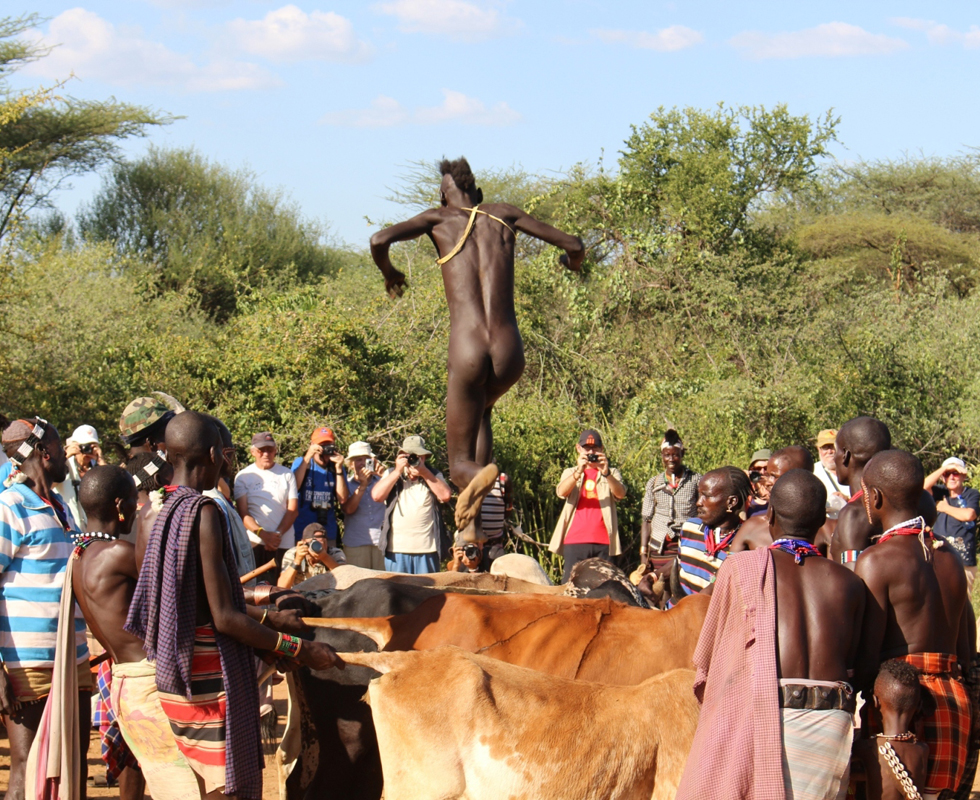
The afternoon sun covers the small clearing in the bush in a magical light, the bulls nervously kick up the dust as the singing and chanting of the women moving in an ecstatic dance between them rises to a crescendo – I feel the tension inside me increase as the young man who is at the center of everyone's attention kneels down in prayer.
It is day 6 of our journey from Africa to Brazil and we are in the remote South Western corner of Ethiopia, 1800km from Nairobi. We are witnessing one of the fabled Bull jumping ceremonies of the local Hamer tribe, an initiation rite for young men into Manhood. Three hours ago, we arrived at this sacred site at the edge of a dry riverbed and since then have observed the young women of the tribe, with their hair swathed in ochre and gleaming with butter, singing and dancing under the mind-numbingly intense sun. We were shocked to see them in regular intervals approaching the men of the tribe and pleading with them to be whipped – each time, the men would oblige and lash them with a cane and a ferocity that made us cringe while the women would not even flinch. We are told that in doing this the women celebrate and show their respect for the young man and intend to give him strength for the task ahead.
 After several hours of this ritual, the ceremony approaches its climax – seven bulls are positioned so that their flanks are close to each other while the young man eyes them with utmost concentration. In order to be accepted as a man in his tribe, he needs to jump and balance over the bulls five times and if he stumbles more than twice, he has failed. In my heart, I am cheering for this young man as he finally takes a leap of faith and onto the row of bulls. My heart, however, sinks when he tumbles on the fourth bull and has to start over again. The tension inside me feels almost like during a penalty shoot-out involving my favorite football team as turn after turn he leaps on and balances over the bulls, and I find myself cheering for him together with the women and the men of the tribe after his final successful turn – yes, he made it!
After several hours of this ritual, the ceremony approaches its climax – seven bulls are positioned so that their flanks are close to each other while the young man eyes them with utmost concentration. In order to be accepted as a man in his tribe, he needs to jump and balance over the bulls five times and if he stumbles more than twice, he has failed. In my heart, I am cheering for this young man as he finally takes a leap of faith and onto the row of bulls. My heart, however, sinks when he tumbles on the fourth bull and has to start over again. The tension inside me feels almost like during a penalty shoot-out involving my favorite football team as turn after turn he leaps on and balances over the bulls, and I find myself cheering for him together with the women and the men of the tribe after his final successful turn – yes, he made it!
Over the course of the last couple of days, we have encountered several of the tribes in Southern Ethiopia who still live a very traditional lifestyle. It is intriguing to see the diversity in their cultures - the most visibly striking are the Mursi whose women insert plates up to the size of a tea saucer into their lower lips. One beauty of a journey is that our hearts are so open when we travel! Travelling and observing foreign cultures makes you reflect about yourself - for the Mursi, a huge plate in the lower lip is a sign of beauty and while this strikes us as odd, it makes us contemplate how curious some of our own traditions are – in what ways are ear and nose rings different from a plate in the lower lip and what again is the usefulness of a tie?
Yesterday, we witnessed a traditional dance of the unmarried women and men of the Hamer tribe. At nightfall they gathered outside their village, with men and women facing each other in two semi-circles. Only the stars lit this scene as they were chanting, singing and dancing. Suddenly, one of the young women would break out of the phalanx and approach a young man on the opposite side. He would either ignore her or move forward and dance with her. This way, the young man and women choose their partner for the night - we were puzzled to hear that these dances happen 3-4 times per week!
 Again, this caused us to reflect about the differences in human culture and customs – while virginity at the time of marriage is a must for the bride among most tribes in Southern Ethiopia, in the Hamer tribe it is frowned upon as it raises the question why no one has ever shown interest in the bride before.
Again, this caused us to reflect about the differences in human culture and customs – while virginity at the time of marriage is a must for the bride among most tribes in Southern Ethiopia, in the Hamer tribe it is frowned upon as it raises the question why no one has ever shown interest in the bride before.
Our Memory Foundation activities enable us to interact with local people in a unique way – with these, we aim to give people in remote areas who don't have any personal pictures a tangible memory of themselves and their loved ones. For this purpose, we have installed a 24 hour power supply and a mobile printer in the vehicle which allows us to print and frame pictures and give them to the people we meet. This completely changes the interactions with the local people who often look at the first picture they have seen of themselves with a touching sense of awe and don't want us to leave until we have taken and printed a picture of all their family and friends.
There have been many intriguing moments during this first week of our 200 day journey. A bit of a culture shock is to be expected in Moyale - if you wish to spend a night in a hotel with your partner and are a married couple, be ready to produce a marriage certificate, otherwise you will be forced to pay for two separate rooms. When crossing into Ethiopia at the Moyale border and reaching the Ethiopian customs and immigration office, we found to our surprise that they have a 2 hour lunch break. Thus, we were left at the mercy of highly-entrepreneurial Ethiopian money changers until the border officials deemed it fit to return from their siesta.
We loved the striking and diverse landscapes – especially Marsabit National Reserve in the heart of the arid plains of Northern Kenya which surprised us with extremely lush vegetation, the awe inspiring El Sod crater and the terraced hills in Southern Ethiopia which suddenly drop into the magnificent Omo Valley where the Omo River flows southwards to feed Lake Turkana.
 The constantly breathtaking views triggered our habit of travelling on the roof rack of our Landcruiser, cushioned with pillows to protect us against the ruts and bumps in the roads. Sitting on top of the car, observing the stunning scenery passing by, kids smiling and waving at us and glancing curiously at the flags flying from our cars, and feeling the warm breeze like a blanket is a wonderful experience! However, it also makes me wonder what it will be like to drive through the arctic temperatures in Russia and Siberia – our AC failed to effectively cool the car in the extreme heat of the Omo Valley and I am a bit uncertain whether the heating of the car will be able to bring temperatures to an endurable level at -40° Celsius.
The constantly breathtaking views triggered our habit of travelling on the roof rack of our Landcruiser, cushioned with pillows to protect us against the ruts and bumps in the roads. Sitting on top of the car, observing the stunning scenery passing by, kids smiling and waving at us and glancing curiously at the flags flying from our cars, and feeling the warm breeze like a blanket is a wonderful experience! However, it also makes me wonder what it will be like to drive through the arctic temperatures in Russia and Siberia – our AC failed to effectively cool the car in the extreme heat of the Omo Valley and I am a bit uncertain whether the heating of the car will be able to bring temperatures to an endurable level at -40° Celsius.
One thing you realize pretty fast is no matter how meticulous you prepare, you must be ready to change your plans, and being open minded and flexible is essential. A couple of days ago, we spent the night in a simple guest house and after a horrendous night we christened the place "Mosquito Village". The builders of the guest house had not found it necessary to place mosquito nets in the rooms or even to have glass in some of the window openings and being tortured at night, I eventually decided to put up my tent in the room to protect myself from the mosquitoes. It worked and I slept the rest of the night with frustrated mosquitoes buzzing around the tent …
Tribute to Kenyan and Ethiopian Roads so far We are glad to have made it to Moyale with our two Landcruisers still breathing. The terrain in Northern Kenya left one of them without a spare tyre - must have gotten lost in the bush as a result of the beautifully corrugated highway. We had three flat tyres so far, and curiously, our two Landcruisers have shown similar signs of exhaustion – their headlights gave up as we got into darkness on the way to Moyale and we had to drive the last 50km with fog lights. Not surprisingly given the constant shaking, the exhaust pipes of both cars broke and needed to be welded. So far, no major damage to the cars and we hope it will stay this way!

